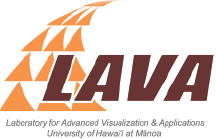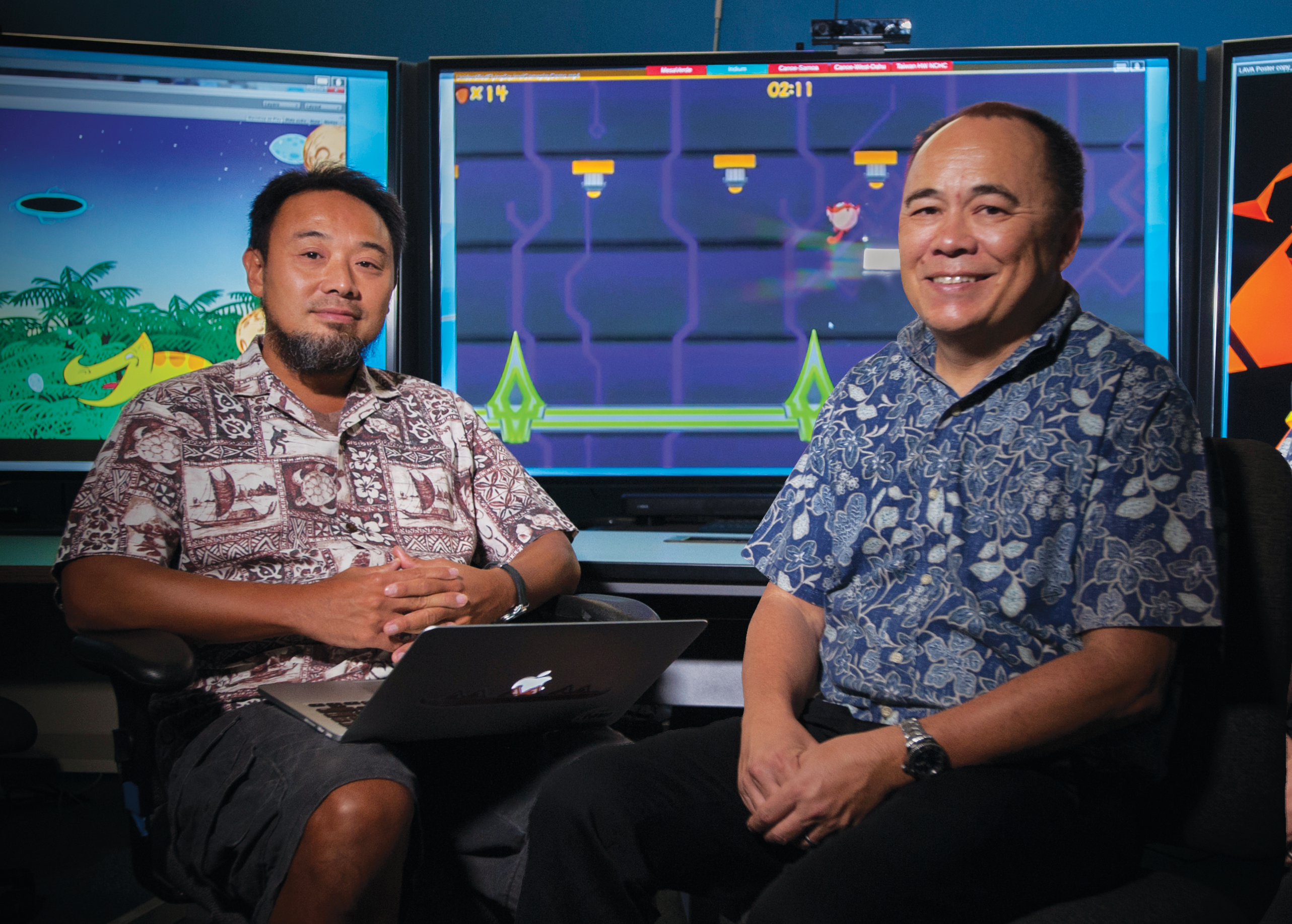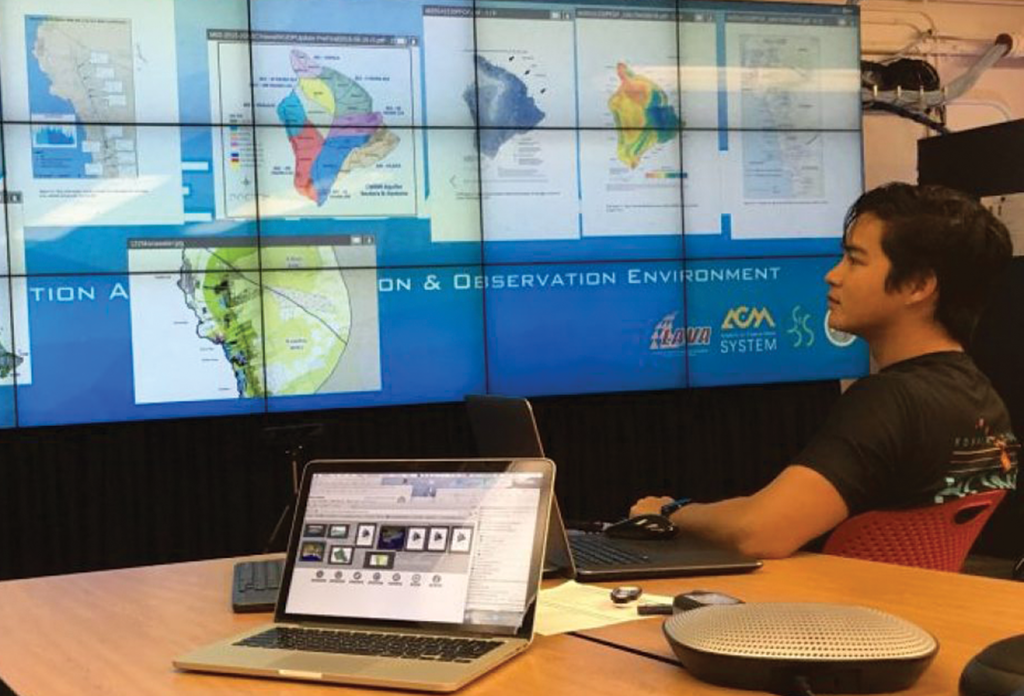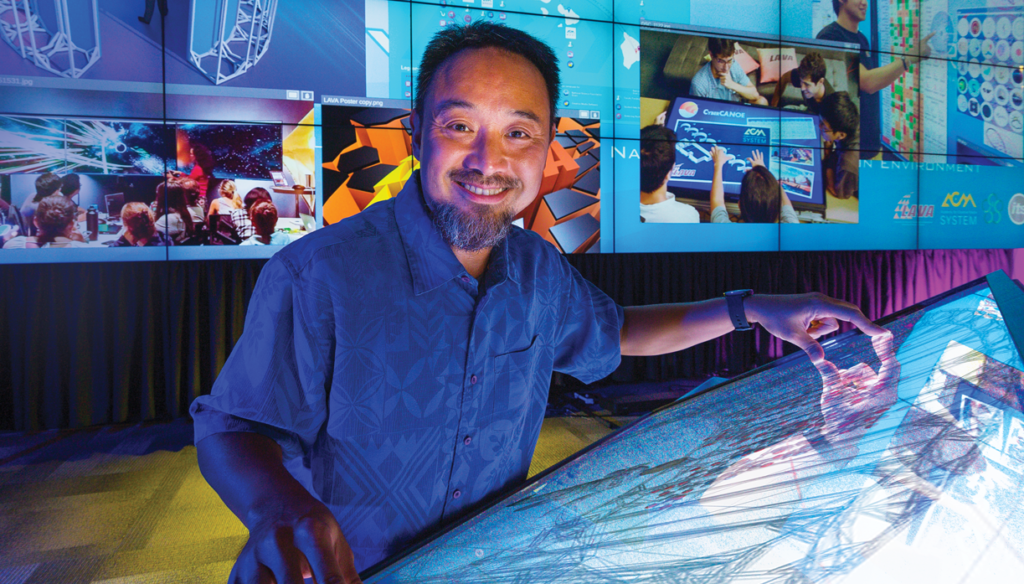A Picture is Worth a Thousand Words
“A picture is worth a thousand words” is an old adage. But with the help of technologies developed by visualization experts like University of Hawai‘i at Mānoa Information and Computer Sciences Professor Jason Leigh, pictures are now worth a whole lot more.
As researchers around the world begin to work more closely with each other to solve complex problems, collaborative scientific visualization environments comprised of ultra-resolution tiled display walls interconnected by optical networks, are becoming vital for data sharing and analysis.
Now, thanks to a major infrastructure grant from the National Science Foundation and funding from the UH System’s Academy for Creative Media (ACM System), UH Mānoa will be home to the best data visualization system in the U.S. Known as the Cyber-enabled Collaboration Analysis Navigation and Observation Environment or CyberCANOE, it represents the culmination of over two decades of experience and expertise for Leigh, who is also the founder
and director of UH Mānoa’s Laboratory for Advanced Visualization and Applications (LAVA).

“…UH Mānoa will be home to the best data visualization system in the U.S.”
—Jason Leigh, founder of LAVA
The UH CyberCANOE will provide an alternate approach to constructing ultra-resolution display environments by using new and completely seamless direct view light emitting diode displays, rather than traditional projection technologies or liquid crystal displays. New 2D and 3D stereoscopic display environment with almost 50 megapixels of resolution will provide researchers with powerful and easy-to-use, information-rich instrumentation in support of cyberinfrastructure-enabled, data-intensive scientific discovery. The net effect is a visual instrument that exceeds the capabilities and overcomes the limitations of the current best-in-class systems at other U.S. universities.
This virtual environment is provided by SAGE (Scalable Adaptive Graphics Environment), a software system developed by Leigh, then director of the prestigious Electronic Visualization Lab and Software Technologies Research Center at the University of Illinois at Chicago. It enables users to access, display and share a variety of data-intensive information, in a variety of resolutions and formats, from multiple sources, on tiled display walls. Information displayed can be digital-cinema animations, high-resolution images, high-definition video conferences, presentation slides, documents and spreadsheets. The SAGE software is the National Science Foundation’s de facto standard for driving ultra-high resolution display walls and is currently in use by over 200 top research and industrial organizations worldwide, including Monsanto and Japan’s NTT.
Building on the highly successful CAVE (CAVE Automatic Virtual Audio Visual Experience), Leigh’s recent CAVE2 is the next generation, large-scale, virtual-reality system that allows researchers to completely immerse themselves in a seamless 2D/3D environment of visual information.
“The CAVE2 technology helps to bring science to the big screen,” said Leigh. “It allows the study of worlds too small, too large, too dangerous or too complex to be viewed otherwise, like the hostile surface of a distant planet or the intricate system of arteries in the human body.”
Leigh’s technologies have already being utilized by UH researchers including Karen Meech at the Institute for Astronomy and by world-renowned oceanographer David Karl at the Center for Microbial Oceanography: Research and Education (C-MORE).
“Jason Leigh has been a terrific addition to UH,” said Karl, the director of C-MORE. “We already have plans for a meaningful collaboration between his new visualization team and C-MORE scientists, who will soon be able to display our marine microbial genomics and biogeochemical datasets in vivid 3-D.”

Currently, there are smaller CyberCANOEs deployed at UH Mānoa’s LAVA and i-Lab, UH West O‘ahu’s Roy and Hilda Takeyama and Hilda Creative Media Lab and at UH Hilo’s ‘Imiloa Astronomy Center. In addition to two more planned locations at UH Hilo, Leigh’s group is working with the State Energy Office and Kamehameha Schools to have CyberCANOEs installed at their facilities.
Last year, students at UH Mānoa and UH West O‘ahu participated in UH’s first joint video game development class made possible by the CyberCANOE. Funding for the multi-screened computer environments was funded by UH System ACM. This year, the newest CyberCANOE at UH Hilo/‘Imiloa is being used to teach a joint class in data visualization between UH Mānoa and UH Hilo.
At least 46 researchers, 28 postdocs, 833 undergraduates and 45 graduate students spanning disciplines that include oceanography, astrobiology, mathematics, computer science, electrical engineering, biomedical research, archeology and computational media are poised to use the UH CyberCANOE for their large-scale data visualization needs. The UH CyberCANOE will also open up new opportunities in computer science research at the intersection of data-intensive analysis and visualization, human-computer interaction and virtual reality.
“We are thrilled to be able to continue our support of Jason Leigh and his team in securing the NSF grant,” said Chris Lee, founder and director of ACM System and a co-principal investigator on the grant. “The new CyberCANOE will build upon the capabilities of the two earlier ‘mini’ versions and help to transcend ACM System into an industry catalyst. ACM System is dedicated to collaboration between programs and campuses throughout UH and already the CyberCANOE has allowed new, innovative courses where students from UH Mānoa, UH West O’ahu and UH Hilo work together.”

The UH CyberCANOE, which is expected to be built in about three years, will enable Leigh’s advanced visualization laboratory to provide scientific communities with highly integrated, visually rich collaboration environments; to work with industry to facilitate the creation of new technologies for the advancement of science and engineering; and to continue ongoing partnerships with many of the world’s best scientists in academia and industry. With the UH CyberCANOE, the lab will also support the country’s leadership position in high-performance computing and in contributing advancements to complex global issues, such as the environment, health and the economy.
“This comes at the best time for the University of Hawai‘i as the number of students interested in information and computer science is skyrocketing. Last year about 170 freshman computer science students entered the program, this year we will receive 270,” said Leigh. “The UH CyberCANOE will give these students access to better technology than what will be available on the continent.”

